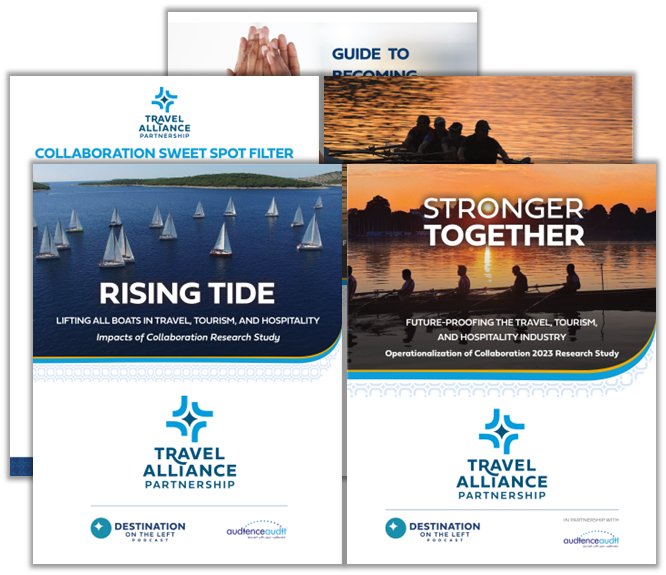How to Market a Destination
Last month, I attended the “Win More Business” workshop for Agency Owners given by Agency Management Institute and The Mercer Island Group. Many of the principles from the workshop apply to how to market a destination. Especially for tourism marketers and CVB sales teams who are looking to attract group, meeting and convention business.

Understanding the Customer
The buying environment has changed. Now more than ever people are making buying decisions based on business issues that they need help solving. Figuring out how to market a destination is more challenging than ever. However, destination marketers can differentiate themselves by identifying and helping to solve their prospects’ business issues.
The profile sheet is an integral part of what the travel industry relies on when preparing for a sales appointment, travel trade show or sales mission. A typical profile sheet might include company or organization name, list of contacts, and description of the audience that they serve. It also may include information on other destinations that they have been to and details of their group size and requirements.
Utilizing Profile Sheets
To help your destination stand-out, you need to take these profile sheets a few steps further. They should identify business issues and implications for your prospect. Put yourself in their shoes and think through every business issue that you can come up with. Add the following questions to the business profile sheet:
- What are the biggest challenges that your prospect faces?
- As a company/organization, what are they trying to accomplish?
- What are their concerns?
Some examples of business issues for a tour operator might be:
- Changing demographics of their customer base is putting pressure on their ability to sell trips
- Shrinking margins due to a change in airlift to a key market that they frequently travel to
Examples of business issues for a meeting planner might be:
- Declining attendance at annual conference
- Pressure from the Association’s Board of Director’s to increase revenues for the organization
- Shrinking budgets of event sponsors
Once you have brainstormed every possible business issue for your prospect, don’t stop there. Go one-step deeper by thinking through the business implications for each of the issues. Implications are the deeper concerns that are driven by the business issue. For example, the tour operator’s business issue is the changing demographics of their customer base. But what they are really concerned about is losing sales revenue, which could lead to staff member layoffs. Spend some time brainstorming implications for each of the business issues and add them to your profile sheet.
The time you have invested in researching and preparing for meeting your prospect will help set you apart.
Differentiating your Destination
Most destination marketers start their conversations with prospects talking about the visitor experiences that they offer and what they can provide to the prospect to make their job easier. This type of approach has worked in the past but buyers are getting inundated with more and more choices now. The real key to differentiation is to change your approach to selling your destination.
Most salespeople position the value that they bring by starting with the solution that they offer, then tying the solution to the problem that the buyer is trying to solve and then talking about the alternatives and why their solution is better. This approach is focused on the seller, not on the buyer.
This seller focused conversation- solution, problem, alternatives, needs to be re-focused on the buyer. Start by talking about the problems that the buyer is facing. Then discuss the possible alternatives and finish with your solution tying it back to the problem. The conversation flow that follows- problem, alternatives, solution – puts the buyer first.
To illustrate this point, we go back to the 1970 “ring around the collar” TV commercial for WISK Detergent. In this spot, WISK identifies the problem, as “ring around the collar,” the alternative solutions as, “soaking, scrubbing and bleaching” and finally they offer the solution “Wisk”. They then tie it back to the problem, “no more ring around the collar.”
With the information in your well-researched company profile, you can develop questions to get the Buyer talking about themselves, their business issues and concerns. With that information in hand you will be better prepared to offer real solutions to buyers, and ultimately win more business!
To learn more about how to create questions that will help you sell, I recommend you check out the book Question Based Selling by Tom Freese.
Related Posts
Welcoming All 2.0: Key Takeaways from Our Community Conversation on Inclusion in Tourism
In our rapidly evolving travel industry, the concept of being a “welcoming destination” is no longer simply about inviting more visitors. It’s about deeply understanding…
10 Must-Listen Podcasts for Travel, Tourism & Hospitality Professionals
I’ve had the joy of hosting Destination on the Left—an award-winning podcast spotlighting the travel, tourism, and hospitality industry—since 2016. My team and I believe…
